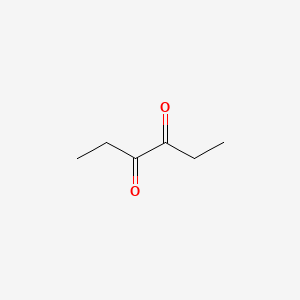
|
3,4-hexanedione |
3,4-hexanedione is a lipid of Fatty Acyls (FA) class. |
9 |

|
1-Palmitoyl-sn-glycerol |
1-Palmitoyl-sn-glycerol is a lipid of Glycerolipids (GL) class. |
30 |

|
9-hydroxystearic acid |
9-hydroxystearic acid is a lipid of Fatty Acyls (FA) class. |
31 |
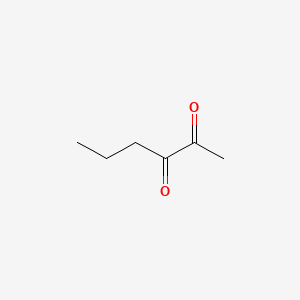
|
2,3-hexanedione |
2,3-hexanedione is a lipid of Fatty Acyls (FA) class. |
33 |

|
2-Methylhexadecanoic acid |
2-Methylhexadecanoic acid is a lipid of Fatty Acyls (FA) class. |
34 |
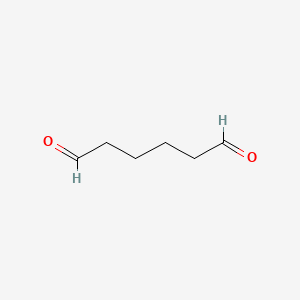
|
Adipaldehyde |
Adipaldehyde is a lipid of Fatty Acyls (FA) class. |
34 |
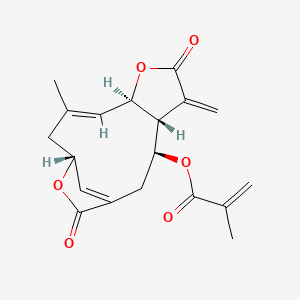
|
Deoxyelephantopin |
Deoxyelephantopin is a lipid of Prenol Lipids (PR) class. |
38 |
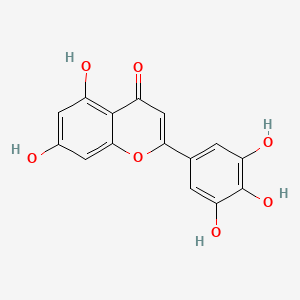
|
Tricetin |
Tricetin is a lipid of Polyketides (PK) class. Tricetin is associated with abnormalities such as Diabetes. The involved functions are known as inhibitors, Inflammation and Chronic inflammation. Tricetin often locates in Blood. The related lipids are Lipopolysaccharides. |
46 |
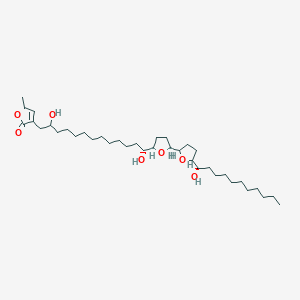
|
Rolliniastatin-1 |
Rolliniastatin-1 is a lipid of Polyketides (PK) class. |
55 |
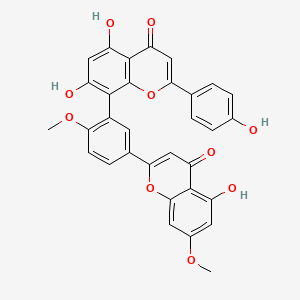
|
Ginkgetin |
Ginkgetin is a lipid of Polyketides (PK) class. |
71 |
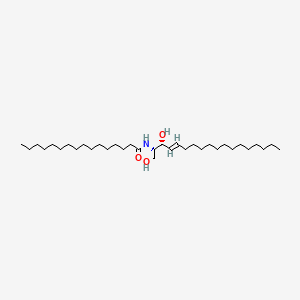
|
N-Palmitoylsphingosine |
N-Palmitoylsphingosine is a lipid of Sphingolipids (SP) class. The involved functions are known as ceramide biosynthetic process, Apoptosis, Regulation, Signal Transduction and Caspase-Dependent Apoptosis. N-palmitoylsphingosine often locates in Mitochondria, Membrane, Extracellular and Endoplasmic Reticulum. The associated genes with N-Palmitoylsphingosine are BCL2 gene, cytochrome c'', BCL2L1 gene, LASS6 gene and LASS5 gene. The related lipids are dihydroceramide, Fatty Acids, Sphingolipids, Palmitates and inositolphosphorylceramide. |
71 |
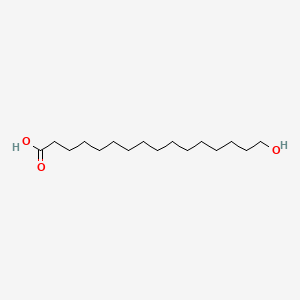
|
Juniperic acid |
Juniperic acid is a lipid of Fatty Acyls (FA) class. |
79 |
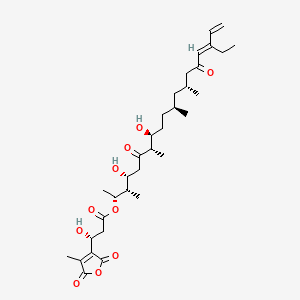
|
Tautomycetin |
Tautomycetin is a lipid of Polyketides (PK) class. Tautomycetin is associated with abnormalities such as Toxic nephropathy and Dehydration. The involved functions are known as Signal, Regulation, Increased Sensitivy, Increased Device Sensitivity and phosphoric monoester hydrolase activity. Tautomycetin often locates in Neurosecretory Systems, Protoplasm, Mitochondria, Transplanted tissue and Blood. The associated genes with Tautomycetin are RAF1 gene, IL2 gene, IL2RA gene, BCL2 gene and cytochrome c''. The related lipids are branched chain fatty acid and Propionate. |
102 |
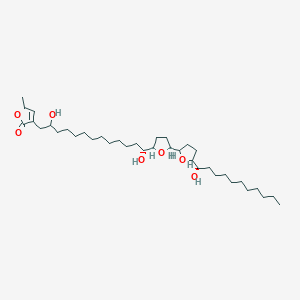
|
Bullatacin |
Bullatacin is a lipid of Polyketides (PK) class. The involved functions are known as inhibitors, Electron Transport, NADH-ubiquinone oxidoreductase activity, NADH oxidation and Point Mutation. Bullatacin often locates in NADH dehydrogenase complex and Submitochondrial Particles. The associated genes with Bullatacin are NDUFS7 gene, CCL14 wt Allele and TERT gene. The related lipids are Annonaceous Acetogenins. |
124 |

|
(2e,4e)-deca-2,4-dienal |
(2e,4e)-deca-2,4-dienal is a lipid of Fatty Acyls (FA) class. |
125 |
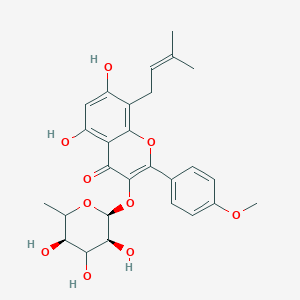
|
Baohuoside 1 |
Baohuoside 1 is a lipid of Polyketides (PK) class. |
130 |
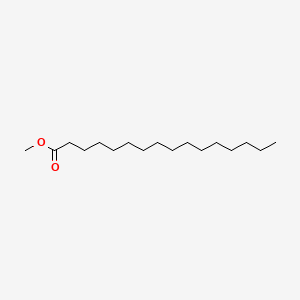
|
Methyl palmitate |
Methyl palmitate is a lipid of Fatty Acyls (FA) class. |
135 |
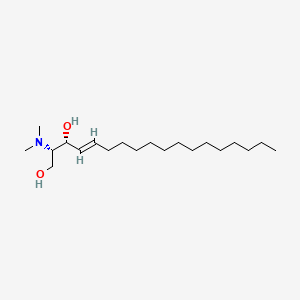
|
N,N-dimethylsphingosine |
N,N-dimethylsphingosine is a lipid of Sphingolipids (SP) class. N,n-dimethylsphingosine is associated with abnormalities such as Exanthema and Increased drug resistance. The involved functions are known as Vmax, Metabolic Inhibition, Anabolism, Binding (Molecular Function) and Cytokinesis. N,n-dimethylsphingosine often locates in yolk, Membrane, CNS - Brain (MMHCC), soluble and Tissue membrane. The associated genes with N,N-dimethylsphingosine are FPR1 gene, ANP32A gene, HPGDS gene, Nuclear phosphoprotein and PTGS2 gene. The related lipids are Sphingolipids, Phosphatidic Acid, Lysophosphatidylcholines, stearylamine and dihydroceramide. The related experimental models are Mouse Model and Knock-out. |
151 |
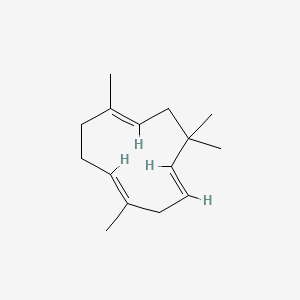
|
Alpha-humulene |
Alpha-humulene is a lipid of Prenol Lipids (PR) class. |
155 |

|
Epothilone A |
Epothilone a is a lipid of Polyketides (PK) class. Epothilone a is associated with abnormalities such as abnormal fragmented structure and Hyperostosis, Diffuse Idiopathic Skeletal. The involved functions are known as Polymerization, Mutation, Depolymerization, Musculoskeletal torsion, function and Negative Regulation of Microtubule Depolymerization. Epothilone a often locates in Microtubules, soluble, Nuclear Structure and Microtubule cytoskeleton. The associated genes with Epothilone A are C9 gene, SLC33A1 gene, KIF2C gene and HMHA1 gene. |
160 |
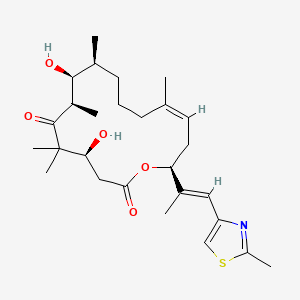
|
Epothilone D |
Epothilone d is a lipid of Polyketides (PK) class. Epothilone d is associated with abnormalities such as Tauopathies, Neutropenia, Neuropathy and Hematological Disease. The involved functions are known as Mutation, Apoptosis, Mitotic arrest, Cell Growth and Anabolism. Epothilone d often locates in Cytoskeleton, Axon, Cell Wall, Chromosomes and Spindle. The associated genes with epothilone D are SLC33A1 gene, Chromatin, GTF2I gene and HEXA gene. |
174 |
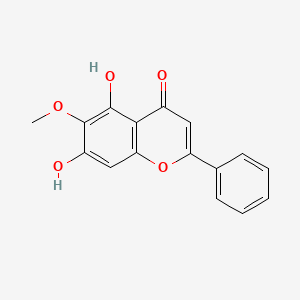
|
Oroxylin A |
Oroxylin A is a lipid of Polyketides (PK) class. |
180 |
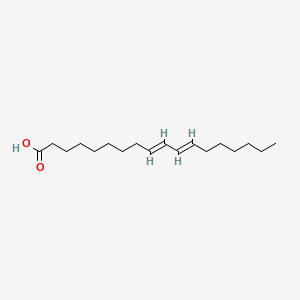
|
9,11-octadecadienoic acid |
9,11-octadecadienoic acid is a lipid of Fatty Acyls (FA) class. |
194 |
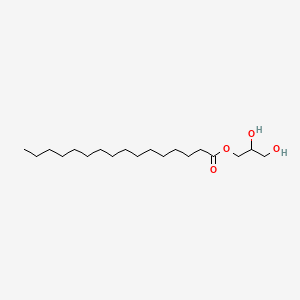
|
1-Palmitoyl-rac-glycerol |
1-Palmitoyl-rac-glycerol is a lipid of Glycerolipids (GL) class. 1-palmitoyl-rac-glycerol is associated with abnormalities such as Eczema, Food Allergy and Fatty Liver. The involved functions are known as inhibitors, lysophospholipase activity, Adjudication, cell transformation and Detergents. 1-palmitoyl-rac-glycerol often locates in Cytosol and soluble fraction. The associated genes with 1-Palmitoyl-rac-glycerol are FASTK Gene. The related lipids are 1,2-oleoylphosphatidylcholine, Lysophospholipids, phenyl valerate, Lysophosphatidylcholines and Palmitates. |
197 |
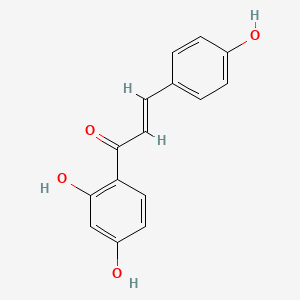
|
isoliquiritigenin |
Isoliquiritigenin is a lipid of Polyketides (PK) class. Isoliquiritigenin is associated with abnormalities such as abnormal fragmented structure, Gastric ulcer, Gastric mucosa lesion, Peptic Ulcer and Wiskott-Aldrich Syndrome. The involved functions are known as Mass-to-Charge Ratio, Anabolism, Oxidation, inhibitors and Energy Absorption. Isoliquiritigenin often locates in Microsomes, Liver, Hepatic, Microsomes, Immune system and Vacuole. The associated genes with Isoliquiritigenin are P4HTM gene, BCL2 gene, AP1AR gene, oxytocin, 1-desamino-(O-Et-Tyr)(2)- and ODAM gene. The related experimental models are Knock-out. |
220 |
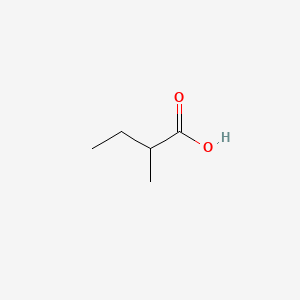
|
2-Methylbutanoic acid |
2-Methylbutanoic acid is a lipid of Fatty Acyls (FA) class. The involved functions are known as Binding (Molecular Function), Oxidation, isoleucine catabolic process, Anabolism and physiological aspects. 2-methylbutanoic acid often locates in Membrane, soluble and host. The associated genes with 2-Methylbutanoic acid are Homologous Gene, Genome, NKS1 gene, HM13 gene and ACSM1 gene. The related lipids are Fatty Acids, Butyric Acids, branched chain fatty acid, Propionate and 2-methylvalerate. |
222 |
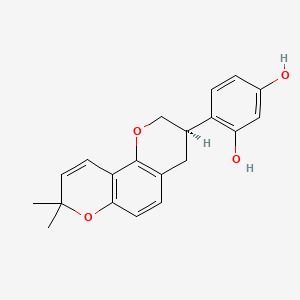
|
Glabridin |
Glabridin is a lipid of Polyketides (PK) class. Glabridin is associated with abnormalities such as Atherosclerosis, CNS disorder, Corn of toe, Fatty Liver and Obesity. The involved functions are known as Energy Absorption, Oxidation, Oxidants, Metabolic Process, Cellular and Drug Interactions. Glabridin often locates in Hepatic, membrane fraction, Microsomes, Microsomes, Liver and Extracellular. The associated genes with Glabridin are P4HTM gene, SPEN gene, SLC33A1 gene, ABCB1 gene and CD9 gene. The related lipids are Nonesterified Fatty Acids, Total cholesterol, Lipopolysaccharides, Hydroxycholesterols and 7-ketocholesterol. The related experimental models are Mouse Model. |
263 |
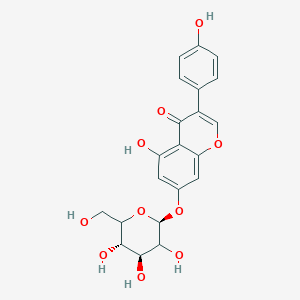
|
genistein 7-O-glucoside |
genistein 7-O-glucoside is a lipid of Polyketides (PK) class. Genistein 7-o-glucoside is associated with abnormalities such as athymia, Heart Diseases, Thyroid Diseases, Plague and Brucella infections. The involved functions are known as Cell Proliferation, Binding (Molecular Function), Ingestion, topoisomerase activity and kinase activity. Genistein 7-o-glucoside often locates in Membrane, Gastrointestinal tract structure, Oral region, Body tissue and Blood. The associated genes with genistein 7-O-glucoside are GLUCOSIDASE, PPP1R1A gene, Homologous Gene, Genome and FUSE gene. The related lipids are Sterols, 1,2-oleoylphosphatidylcholine, Membrane Lipids and DOPE. |
264 |
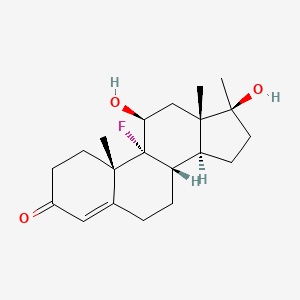
|
Fluoxymesterone |
Fluoxymesterone is a lipid of Sterol Lipids (ST) class. Fluoxymesterone is associated with abnormalities such as Anemia. The involved functions are known as Stimulus. Fluoxymesterone often locates in Entire bony skeleton. |
280 |
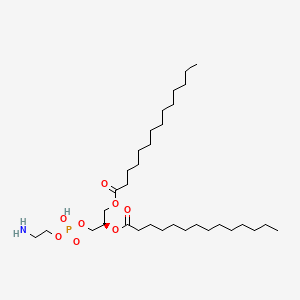
|
998-07-2 |
998-07-2 is a lipid of Glycerophospholipids (GP) class. 998-07-2 is associated with abnormalities such as Abnormal shape, Influenza, Cardiovascular Diseases, Rheumatoid Arthritis and Morphologically altered structure. The involved functions are known as Pressure- physical agent, Physiologic Organization, Process, Drug Interactions and Baresthesia. 998-07-2 often locates in I band, Membrane, Lipid Bilayers, Head and Tissue membrane. The associated genes with 998-07-2 are ATR gene, Fusion Protein and ADRBK1 gene. The related lipids are dimyristoylphosphatidylglycerol, 1,2-dimyristoylphosphatidylethanolamine, 1,2-oleoylphosphatidylcholine, Octanols and Membrane Lipids. |
283 |

|
(-)-Perillyl alcohol |
(-)-perillyl alcohol is a lipid of Prenol Lipids (PR) class. The involved functions are known as Cell Cycle Progression, Cell Cycle, Cell Proliferation, Apoptosis and Isoprenylation. (-)-perillyl alcohol often locates in Cytoplasm, Membrane and Plasma membrane. The associated genes with (-)-Perillyl alcohol are JUN gene, Candidate Disease Gene, IL24 gene, BCL2L1 gene and CFB gene. The related experimental models are Transgenic Model. |
299 |

|
Quercetin 3-beta-D-glucoside |
Quercetin 3-alloside is a lipid of Polyketides (PK) class. Quercetin 3-alloside is associated with abnormalities such as Vitelliform dystrophy. The involved functions are known as sugar binding and Docking. |
319 |

|
Quercetin 3-beta-D-glucoside |
Quercetin 3-alloside is a lipid of Polyketides (PK) class. Quercetin 3-alloside is associated with abnormalities such as Vitelliform dystrophy. The involved functions are known as sugar binding and Docking. |
319 |
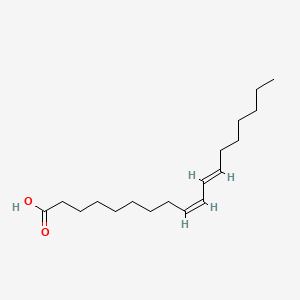
|
Rumenic acid |
Rumenic acid is a lipid of Fatty Acyls (FA) class. Rumenic acid is associated with abnormalities such as Atherosclerosis, Vascular lesions, Hyperlipidemia and Consumption-archaic term for TB. The involved functions are known as Fatty streaks, Transcriptional Activation, Atherogenesis, cholesterol transport and ATP binding. Rumenic acid often locates in Blood and Body tissue. The associated genes with Rumenic acid are ABCA1 gene, apolipoprotein SAA, FATE1 gene and TFCP2 gene. The related lipids are 9,11-linoleic acid, (E,Z)-isomer, 9,11-linoleic acid, Fatty Acids, 11-octadecenoic acid and Total cholesterol. |
324 |

|
29623-28-7 |
29623-28-7 is a lipid of Fatty Acyls (FA) class. |
324 |
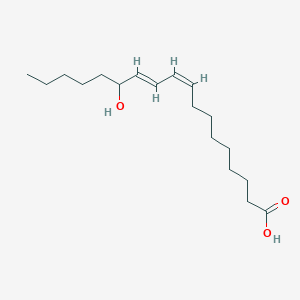
|
Coriolic acid |
Coriolic acid is a lipid of Fatty Acyls (FA) class. The involved functions are known as Autoimmunity, Autoimmune, T-cell differentiation, Binding (Molecular Function) and T-Cell Activation. The associated genes with Coriolic acid are IL2 gene. The related lipids are 9-hydroxy-10,12-octadecadienoic acid, hydroxy fatty acid and octadecadienoic acid. |
326 |

|
L-norvaline |
L-norvaline is a lipid of Fatty Acyls (FA) class. L-norvaline is associated with abnormalities such as Celiac Disease, Exanthema, Atherosclerosis, Plasmodium falciparum infection and Parasitemia. The involved functions are known as Anabolism, Saturated, Stimulus, Physiologic Organization and arginase activity. L-norvaline often locates in Extracellular, Protoplasm, soluble, viral nucleocapsid location and Cell Wall. The associated genes with L-norvaline are norvaline, Amino Acids, Basic, ARG1 gene, Escherichia coli Proteins and Operon. The related lipids are Lipopolysaccharides. |
328 |
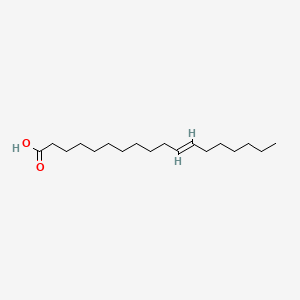
|
trans-vaccenic acid |
Trans-vaccenic acid is a lipid of Fatty Acyls (FA) class. |
341 |

|
Crocetin |
Crocetin is a lipid of Prenol Lipids (PR) class. Crocetin is associated with abnormalities such as abnormal fragmented structure, Gout, Infection and athymia. The involved functions are known as Cytokinesis, Anabolism, enzyme mechanism, Pathological accumulation of air in tissues and Hemorrhage. Crocetin often locates in Vacuole, Cytoplasmic matrix, Body tissue, Mitochondria and Blood. The associated genes with Crocetin are cytochrome c'', BCL2 gene and PCNA gene. The related lipids are mycorradicin. |
350 |
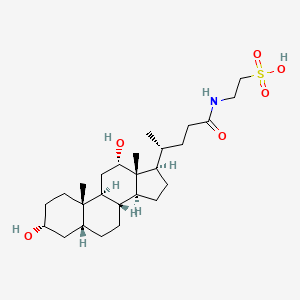
|
Taurodeoxycholic acid |
Taurodeoxycholic acid is a lipid of Sterol Lipids (ST) class. Taurodeoxycholic acid is associated with abnormalities such as Ischemia and Wiskott-Aldrich Syndrome. The involved functions are known as Cell Proliferation, Transcriptional Activation, Phosphorylation, Anabolism and Biochemical Pathway. Taurodeoxycholic acid often locates in Body tissue, Epithelium, Blood, Mucous Membrane and Hepatic. The associated genes with Taurodeoxycholic acid are NOX5 gene, GPBAR1 gene, NR1H4 gene and SLC33A1 gene. The related lipids are cholanic acid, taurolithocholic acid 3-sulfate, Sterols, 7-dehydrocholesterol and tauromuricholic acid. |
352 |
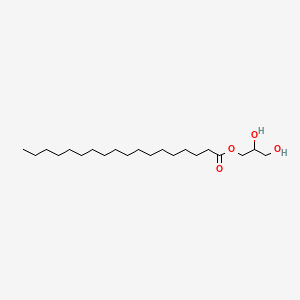
|
Glyceryl monostearate |
Glyceryl monostearate is a lipid of Glycerolipids (GL) class. |
353 |
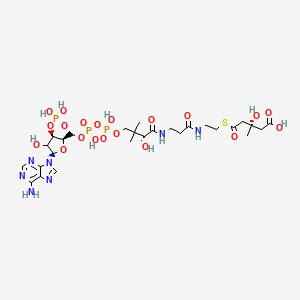
|
HMG-CoA |
Hmg-coa is a lipid of Fatty Acyls (FA) class. Hmg-coa is associated with abnormalities such as Cardiovascular Diseases, Hypercholesterolemia, Metabolic Diseases, Hyperhomocysteinemia and Morphologically altered structure. The involved functions are known as ketone body biosynthetic process, Regulation, Mutation, enzyme activity and HMG-CoA synthase activity. Hmg-coa often locates in Mitochondria, Cytoplasmic matrix, Hepatic, Membrane and Flank (surface region). The associated genes with HMG-CoA are Human gene, HMGCS2 gene, PPARA gene, ACSL1 Gene and Candidate Disease Gene. The related lipids are Fatty Acids, Sterols, Dehydrocholesterols, Lipopolysaccharides and 7-dehydrocholesterol. |
355 |
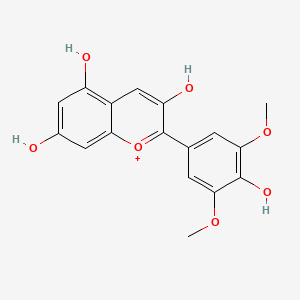
|
Malvidin |
Malvidin is a lipid of Polyketides (PK) class. The involved functions are known as conjugation. |
363 |
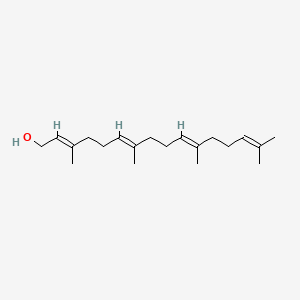
|
Geranylgeraniol |
Geranylgeraniol is a lipid of Prenol Lipids (PR) class. Geranylgeraniol is associated with abnormalities such as abnormal fragmented structure, Hyperostosis, Diffuse Idiopathic Skeletal and Tuberculosis. The involved functions are known as Positive Regulation of Apoptosis, Anabolism, Prenylation, Apoptosis and pathologic cytolysis. Geranylgeraniol often locates in Body tissue, Cytoplasmic matrix, Red Cell Ghost, Spindle and Nuclear lamin. The associated genes with Geranylgeraniol are MST1 gene, STN gene, UMOD gene, ABCA1 gene and RHOA gene. The related lipids are Sterols, Hydroxycholesterols, SK&F 104976 and 25-hydroxycholesterol. |
403 |
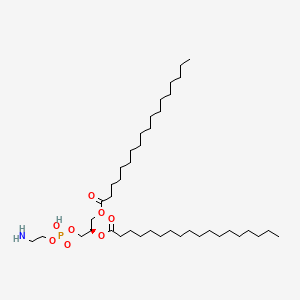
|
1,2-Distearoyl-sn-glycero-3-phosphoethanolamine |
1,2-Distearoyl-sn-glycero-3-phosphoethanolamine is a lipid of Glycerophospholipids (GP) class. 1,2-distearoyl-sn-glycero-3-phosphoethanolamine is associated with abnormalities such as Painful Bladder Syndrome, Dehydration, Renal tubular disorder, Gigantism and Tumor-Associated Vasculature. The involved functions are known as conjugation, Ligand Binding, Process, Laser-generated electromagnetic radiation and Blood Circulation. 1,2-distearoyl-sn-glycero-3-phosphoethanolamine often locates in Tissue membrane, Early endosome, Body tissue, Cell surface and Membrane. The associated genes with 1,2-Distearoyl-sn-glycero-3-phosphoethanolamine are R peptide, P4HTM gene, NHS gene, TSPO gene and SLC33A1 gene. The related lipids are Liposomes, 1,2-distearoylphosphatidylethanolamine, Micelles, Fatty Acids and sialogangliosides. |
438 |
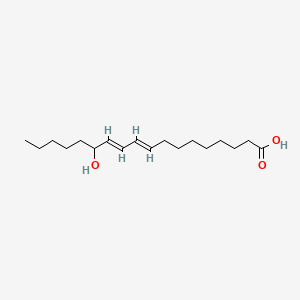
|
alpha-artemisic acid |
Alpha-artemisic acid is a lipid of Fatty Acyls (FA) class. |
448 |
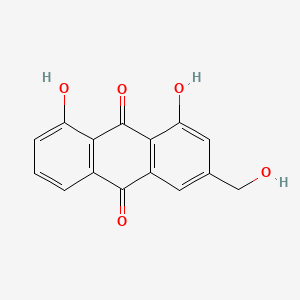
|
Aloe-emodin |
Aloe-emodin is a lipid of Polyketides (PK) class. Aloe-emodin is associated with abnormalities such as Wiskott-Aldrich Syndrome. The involved functions are known as Anabolism, Phosphorylation, Signal Transduction, Cell Proliferation and Cell Survival. Aloe-emodin often locates in Body tissue, Cell Fraction, Mitochondria, Micronucleus and Microsomes, Liver. The associated genes with Aloe-emodin are MECHANISTIC TARGET OF RAPAMYCIN COMPLEX 2, RICTOR gene, PI3 gene, PRR5 gene and MANEA gene. |
451 |
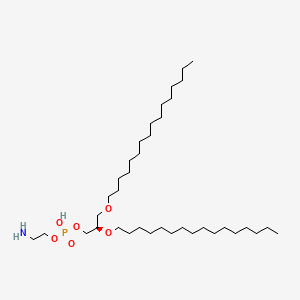
|
61423-61-8 |
61423-61-8 is a lipid of Glycerophospholipids (GP) class. 61423-61-8 is associated with abnormalities such as Superficial ulcer, Spastic syndrome, Morphologically altered structure, Dysentery, Shigella dysenteriae and Cholera. The involved functions are known as Force, vesicle fusion, Physiologic Organization, Drug Interactions and Pressure- physical agent. 61423-61-8 often locates in biological membrane, Tissue membrane, Head, Membrane and Cell membrane. The associated genes with 61423-61-8 are ATR gene, glycyl-glycyl-glycine, Protein Structure, Polypeptides and MCC gene. The related lipids are 1,2-oleoylphosphatidylcholine, proteoliposomes, Sphingolipids, Sterols and DOPE. |
457 |
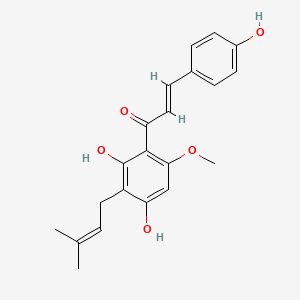
|
Xanthohumol |
Xanthohumol is a lipid of Polyketides (PK) class. Xanthohumol is associated with abnormalities such as Endometriosis, site unspecified, Cyst, peritoneal lesion, Proliferative inflammation and furuncle. The involved functions are known as Cell Proliferation, Signal Transduction, Pathologic Neovascularization, Adverse effects and Proliferation (morphologic abnormality). Xanthohumol often locates in peritoneal, Mesentery, Membrane, Tissue specimen from uterus and Cell Nucleus. The associated genes with Xanthohumol are PI3 gene, KEAP1 gene, SLC33A1 gene, BCR-ABL Fusion Gene and BIRC5 gene. The related lipids are Fatty Acids and Palmitates. The related experimental models are Knock-out. |
465 |
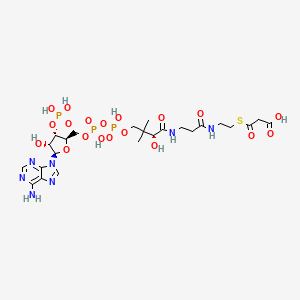
|
Malonyl-coa |
|
492 |

















































